Kara Mustafa made a tragic mistake near Vienna. He ignored the warnings of the spies who reported on Sobieski's relief. The Polish triumph decided the fate of Europe.
"The leader was overwhelmed with such a high opinion of himself and such carelessness that he did not give any credence to the tongues seized, nor did he order (on his own) to undertake spies" - wrote a 17th-century Turkish chronicler about Kara Mustafa. However, the grand vizier had to pay dearly for this lack of thrift. The Prophet's green banner instead of the tower of St. Stefan almost got under the hooves of the Polish hussars.
The underestimated threat
To this day, the attitude of Kara Mustafa is astonishing. After all the expedition to the heart of Europe organized in 1683 on a grand scale should be the apple of the Turkish commander's eye . Meanwhile, a great heart, even though he managed to amass an army of over 100,000 (and according to some estimates as many as 300,000 soldiers), he generally disregarded the enemy. He didn't even take the heavy cannons and mortars with him - so necessary during the conquest of cities.
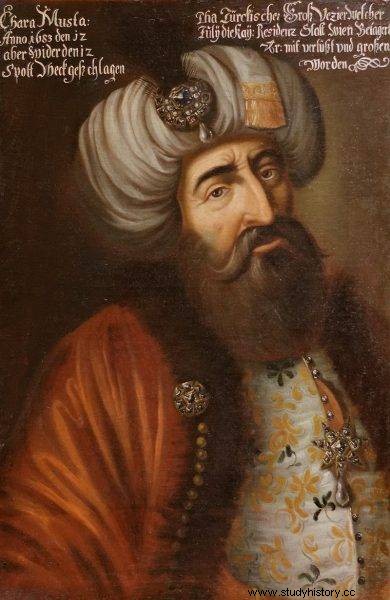
To this day, the attitude of Kara Mustafa is astonishing.
Moreover, from the moment his army closed Vienna with a siege ring, on July 14, he clearly downplayed the possibility of the relief of the king of Poland. . Even when on September 4 he received, indeed greatly exaggerated, data about the approaching 120,000 army of Jan III Sobieski has not taken any major preventive measures in this regard. The Turkish commander simply did not believe in the loyalty of the Polish ruler to Emperor Leopold, who had been tied by the alliance for just a few months.
Missed horoscope
"The calendar of Emperor Leopold I for 1683 contained an astrological prediction that this year Austria and Europe would be in an undisturbed peace ”- wrote the eminent historian Janusz Pajewski once. However, when, in January of that year, Sultan Mehmed IV's war bouquets were displayed in front of his palace in Istanbul, the Austrian ruler was horrified to find out how badly the horoscope had been set for him. A few months earlier, had been under the delusion that Porta would direct the blade of his expansion somewhere else. The emperor's envoy to the Sultan's court was even supposed to suggest to Leopold that "it would be possible for a considerable sum of money to postpone the war from us and direct it to Poland ”.
It turned out that the diplomatic efforts under the green table had nothing to do with the will of Mehmed IV. For the latter, feeling heir to the Byzantine Basileuses, wanted a kind of reconstruction of the Roman Empire under his own rule. And it was the Habsburgs who stood in the way of the implementation of this plan. In this situation, Leopold had to look for an ally he found in the person of the Polish king .
Sobieski was also aware of the increasing threat posed by the Ottoman state and tried on his own to assemble an anti-Turkish alliance with France, Sweden and Russia . In view of the failure of these efforts, the Habsburg alliance proposal seemed to be the only solution. At the same time, the Polish ruler intended to win back his defeats in the struggle with Turkey and regain lost large parts of Ukraine and Podolia. The specter of a common enemy led to the conclusion of in April 1683 the Polish-Imperial alliance . Sobieski and Leopold agreed that in the event of a threat to Krakow or Vienna, the other side would rush to help. In addition, the emperor and the pope, who was also the guarantor of the treaty, were to participate in the maintenance of the Polish army.
A faithful ally
It was high time for alliances. Already at the beginning of July, the imperial resident in Warsaw informed King John about the approach of the Turks to Vienna and about the emperor's hasty departure from the capital. It is therefore time to fulfill allied obligations.
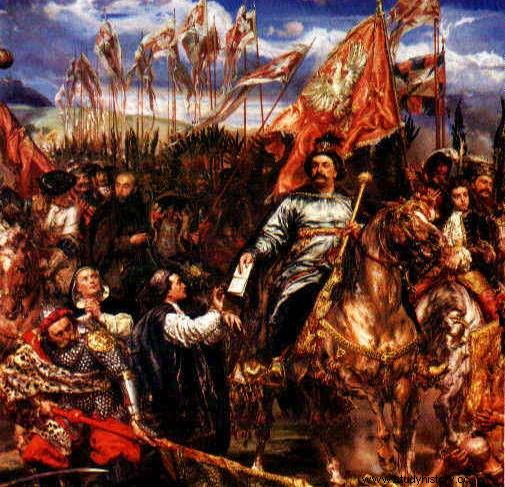
Sobieski's energy, his military knowledge and experience achieved surprising and rare things in the history of Poland in a short time
As Janusz Pajewski wrote:"Sobieski's energy, his military knowledge and experience in a short time accomplished amazing and rare things in the history of Poland". In April, under the influence of royal efforts, high taxes were efficiently passed to field a strong army. Already around mid-August, most of the Crown's forces (they did not wait for Lithuanians who were to join on the way, but eventually never reached the walls of Vienna) set off from Krakow towards the capital of the Holy Roman Empire. The enthusiasm and conviction of the war were enormous . The king himself even had to say: "It will be easy in Poland for Turkish horses" .
Great show
The pace of the march of the Polish army (laden with a huge, 6-8 thousand carriages) through Silesia, Moravia and the Czech Republic towards the imperial capital was impressive. Traveling up to 27 km a day, by the standards of the time, was an admirable result. In order to reach Vienna as quickly as possible, Sobieski gave up heavy artillery, bringing only 28 light cannons with him.
Thanks to this, the Polish relief, after being welcomed in Hollabrunn by the commander-in-chief of the imperial troops, Fr. Karol Lorraine, at the end of August she was some 50 km north of Vienna . On the other hand, on September 3, near Tulln on the Danube - where the allied forces had joined - a war conference of the commanders of the allied forces was held. And these, although they were far from the original size of Kara Mustafa's army, still looked impressive.
Jan III Sobieski, who, moreover, was entrusted with the command, had at his disposal over 26,000. Crown troops (including 2.5 thousand famous hussars), nearly 23 thousand. imperial soldiers and as many as 29 thousand. armed hosts issued by German states. It is true that some of these forces were delegated to protect the Danube crossings and the rolling stock, but still tired of the siege, Vienna could count on the support of 70,000 coalition forces supported by nearly 150 guns.
Ordre de bataille
In the course of stormy disputes near Tulln, the order of battle and the main objective of the operation were also decided. Ultimately, supported by Sobieski's royal majesty and his wartime experience, the plan assumed that after the Danube crossing, the coalition forces would move in three columns towards Vienna along the right bank of the river . Left, consisting of the imperial forces and led by Fr. Lorraine, was to move along the Danube road. The middle one, made up of regiments of German states led by Fr. Jerzy Fryderyk Waldeck, and the law, composed of the Crown forces under the nominal command of Grand Hetman Stanisław Jabłonowski, were to advance through the Vienna Forest.
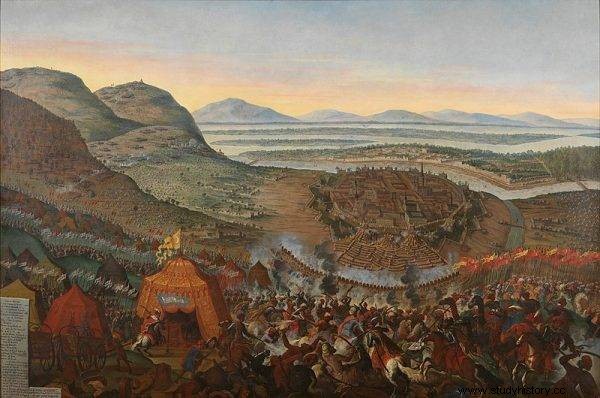
After reaching the suburban plain, the imperial wing was to bind the Turks
After reaching the suburban plain, the imperial wing was to engage the Turks in combat, to divert their attention together with the German troops entering the fight from the maneuver performed by the right wing of the allied forces. These, on the other hand, should then be on the highest range of hills surrounding the city and make a decisive attack against Kara Mustafa's forces.
Pride and carelessness
Although the crossing of the allied forces carried out on 5-8 September was only 25 km from the grand vizier's forces, the grand vizier did not seem to know anything about it. Meanwhile, Kara Mustafa was regularly informed of the impending danger. But, confident in the strength of his army, he did not really bother about it. The only change in his actions was intensification of the firing of Vienna and initially delegating the cavalry and a few Janissary troops towards the slopes of the hills surrounding the city. Only when the forces of Fr. Lorraine began to appear on the horizon of the Danube tract and the lines of the Leopoldsberg and Kahlenberg hills on September 10, the great serdar sent 60 guns against them and began to deploy more infantry from under the walls of Vienna.
Waiting for the king
These ad hoc actions by Kara Mustafa allowed him to slow down the attack of Fr. Lorraine. Moreover, the Turkish troops introduced put up strong resistance, even carrying out strong counterattacks. There were hand-to-hand combat and several dangerous charges of Ottoman spahis. Only massive musket and cannon fire forced them to retreat.
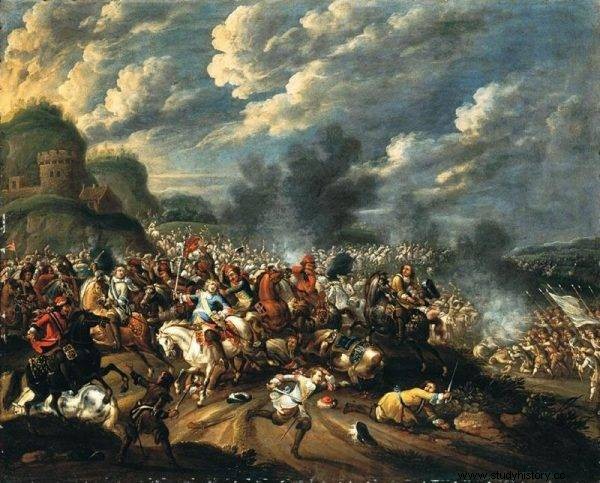
Originally, the plan of the Polish king was to carry out a two-day battle.
Despite this success, around 13 the imperial commander - according to the royal order - stopped the attack while waiting for the front to be leveled by the remaining coalition forces. At that time, there were already branches of the center of Fr. Waldeck, which, after not less severe battles, reached the line of the Austrian troops in the afternoon. Tired of the strenuous march from the Danube and the hours of fighting, the soldiers eagerly fell into their positions waiting for the appearance of Polish troops on the right wing.
The Poles are coming
Kara Mustafa wanted to use this moment of breath on the front line to strengthen his forces. He still saw the main threat only in the imperial and German armies. Meanwhile, only around 14 the first royal troops began to appear on the southwestern peaks of the Vienna Woods. . Yes, the Poles set off to their positions at dawn, but tearing through the terrain full of valleys and hills was quite a challenge - especially for artillery. The strenuous march was also hampered by the harassing actions of the few, but valiant, troops of Janissaries previously sent to these areas by the Grand Vizier.
Ultimately, however, around 16 crown soldiers managed to take up positions in all four hills ruling over the suburban valley, where the Turkish lines were forming in a hurry. Polish ranks tried to confuse the Tatars, but they were efficiently spent by the royal dragoons. Thus, the allied army created a single front, 5-6 km wide and arranged in several lines. Now only Sobieski's decision was waiting.
Recon by fight
Originally the Polish king's plan was to carry out a two-day battle. The first day was to bring favorable positions for the decisive attack on the next day. Meanwhile, Sobieski found with satisfaction that the battle situation was developing better than he had expected. The Polish ruler from his position on Kahlenberg saw perfectly well how great the confusion was in the Turkish ranks. But he also saw how Kara Mustafa, admittedly in time, pulls more troops straight ahead of his troops from under the walls of Vienna. In this situation, decided that it was possible and necessary to finish the relief case before dark - before the enemy becomes established.
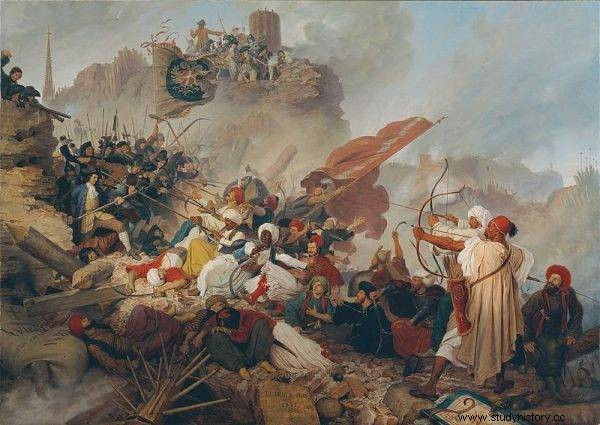
The reconnaissance reached the vicinity of Kara Mustafa's post.
Sobieski, however, did not want to risk a general battle in unknown and uncertain terrain. Until now, inaccurate maps exposed his people to tear through the Vienna Forest littered with obstacles that cartographers did not take into account. For this, ordered a few test charges to explore the enemy's terrain and defensive capabilities . The reconnaissance reached the vicinity of Kara Mustafa's position. But although he brought bloody losses in the Polish ranks and an attempted Turkish counterattack, he gave the king a clear answer to his doubts - the slopes of the hills are suitable for a great cavalry attack that the enemy will not be able to oppose.
The Charge of the Century
Just like in the morning, the first attack started at approx. 18 wing of Fr. Lorraine . The artillery-supported imperial cavalry with assigned hussar banners quickly broke through the resistance of the Turks in this section. At the sight of this the 20,000 Polish, Imperial and German cavalry formation led personally by Sobieski , to the blast of hurricane fire from cannons and muskets, she set off from the slopes of the Vienna Woods. The king, regardless of his own safety, led the charge almost to the Turkish positions. Only at the last moment, with the personal mail, he jumped aside to watch with admiration as the iron fist of the Christian cavalry slams into the ranks of the soldiers of Islam.
Over 2,000 hussars rushing at the head quickly crumbled their copies. Koncerzy were taken, broadswords were set in motion. The sabers of the armored and light cavalrymen advancing behind the backs of the winged riders ran with Turkish blood. The imperial and German cuirassiers were not inferior to them in the work of destruction. It did not help that the Grand Vizier brought almost all the forces from under the walls of Vienna just before the attack. The violence and the force of the blow were so great that the Ottoman foot soldiers and artillerymen had time to fire only once . Attempts to contract any spahis were unsuccessful. It was a doomsday for the Prophet's followers.
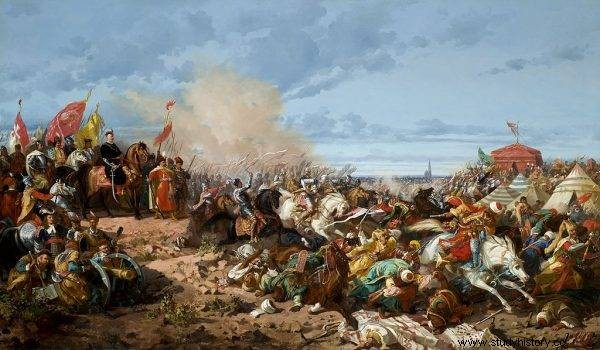
Attempts to contract any spahis were unsuccessful. It was a doomsday for the Prophet's followers.
Vienna saved!
Only the adjutant troops of Kara Mustafa put up a greater resistance, fighting like a simple soldier, he tried at all costs to cover the escape of his defeated troops . His sacrifice paid off. Busy fighting the guards and capturing the barricaded camp of the vizier, Sobieski's army lost momentum. Thus, they were unable to cut off the Turks' escape route and completely destroy their forces. Sam the Grand Vizier also managed to get out of the battlefield at the last moment , saving the Holy Banner of the Prophet.
Although the royal plan to annihilate Kara Mustafa's army failed, it was estimated at 15,000-20,000. Ottoman losses - with only 1.5 thousand. fallen allies - they were very severe. The great serdar also had to say goodbye to all artillery, most of the treasury and to his dream, described by chroniclers, that "he would not be at peace until St. Piotr (in Rome) will not be turned into a stable by a Sultan. ”
